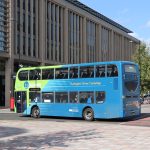What happens after Euro 6 is dealt with is likely to be a start on urban diesel bans. That’s problematic if you run coaches. ZF has an early fix to it with a bolt-on hybrid module that enables engine-off running
Zero emission (ZE) for coaches is coming. That’s the message from ZF, which has revealed details of the passenger-carrying application of its Traxon automated manual gearbox’s hybrid bolt-on.
Traxon replaces AS-Tronic. It is a modular product; various units can be added including the hybrid package, centrepiece of which is an electric motor on the back of the main casing.
It is accompanied by a battery pack, which is charged during driving under diesel power. Geofencing software can ensure that those batteries are at full capacity when entering a specified zone. Drive is thence taken only from the electric motor. The engine is switched off.
The batteries impose a hefty weight penalty, but outside restricted areas a diesel’s range and flexibility is retained. The hybrid package also lacks the further additional mass associated with full electric propulsion.
There is as yet no suggestion that ZE capability will be available with the EcoLife automatic gearbox.
Two axle good…
ZF has extensively modelled the hybrid unit within a coach engine bay. In two-axle chassis, it fits easily. Tri-axles are trickier, but a possible compromise is to hand.
The electric motor also acts as a generator. ZF’s preference is for battery charging to take place when braking or descending hills rather than being drawn directly from the alternator. As energy recuperation imposes significant driveline resistance, that may allow deletion of the Intarder.
Under that circumstance, the net additional space claim of the hybrid unit is zero. ZF says that electrical regeneration combined with an engine brake gives ample auxiliary stopping power.
The manufacturer estimates that for propulsion only, the energy consumption of a coach utilising electric drive is in the region of 1kW per km. To that must be added the draw of the air-conditioning or heating. In urban driving, overall power use will peak at 3kW per km in high ambient temperatures. As 30km is regarded as the minimum urban engine-off range, that mandates 90kW of energy capacity.
The current benchmark is that 1kW of stored electrical energy equals 10kg of battery mass. Thus there will be a 900kg weight gain with the hybrid pack. However, ZF is committed to working with OEMs to remove weight elsewhere via smart component integration. Supercapacitors are also an alternative storage medium that would suit the coach application.
Future flexibility
The potential for almost a tonne increase in unladen weight is concerning. But if and when diesel is banned outright in some urban centres, use of a small hybrid unit appears to as yet be the optimal way of dealing with that while retaining a useable range elsewhere.
ZF tempers weight worries by pointing out that battery energy density is continually rising. That will reduce the additional mass in time, or allow a greater engine-off range.
The latter can be achieved sooner thanks to modular batteries. If the operator can stomach still more weight, potentially 70km of ZE capability can be incorporated from the start.
On the road
No coaches have yet been built with a hybrid-enabled Traxon gearbox. But some HGVs have, and the general application is identical. routeone was able to drive such an Iveco tractor unit recently to gain a feel of how it performs.
Welcome is how the start-up and overall driving experiences are exactly the same as in a conventional vehicle. No geofencing was configured, and so the motor engaged as and when the control system dictated.
In a difference to a fully-ZE vehicle, there are perceptible (and audible) gearshifts when in engine-off mode. Due to the lack of driveline noise they are more obvious than would otherwise be the case, but ZF’s engineers point out that the hybrid concept is still being fine-tuned. There is theoretically no upper limit to the speed attainable under electric propulsion, but the motor’s rating of 130kW means that it is limited in its ability to achieve much above 30mph.
Nevertheless, it is significant that technology is here for ZE in coaches. More will surely follow. Market intelligence suggests that it will be required in a major way in coming years, and it’s difficult to argue with that perception.
If ZF can reduce the hybrid package’s weight, it may be an acceptable solution to a problem that, while not one that operators would choose to address, is likely to become something that for many is unavoidable in the long-term.
routeone comment
The question of delivering zero-emission capability in coaches is one that will follow Euro 6 retrofit just as night follows day. Some cities have already made it clear that the time will come where diesel is banned. Others will inevitably follow their lead.
ZF is ahead of the game with its Traxon hybrid module. It has done a substantial amount of work in preparing it for the coach application. It’s not ready for production yet, but it will be soon.
The key now is to reduce the battery mass. 900kg is a significant addition, particularly to two-axle coaches that are already weight critical on the rear axle in many cases when fully loaded.
Perhaps now is the time for the government to look at a relaxation of the regulations to permit the utilisation of the 13,000kg maximum that many drive axles are already designed for.
Or is that too much like joined-up thinking?

























